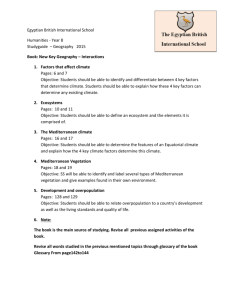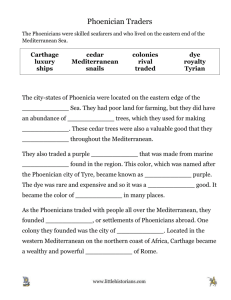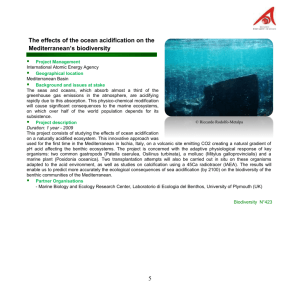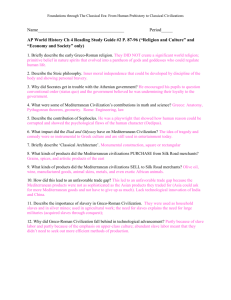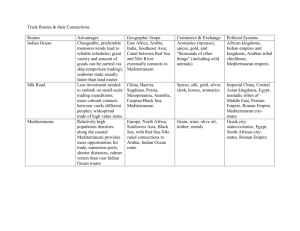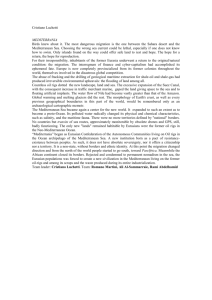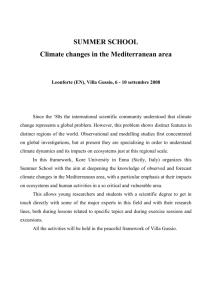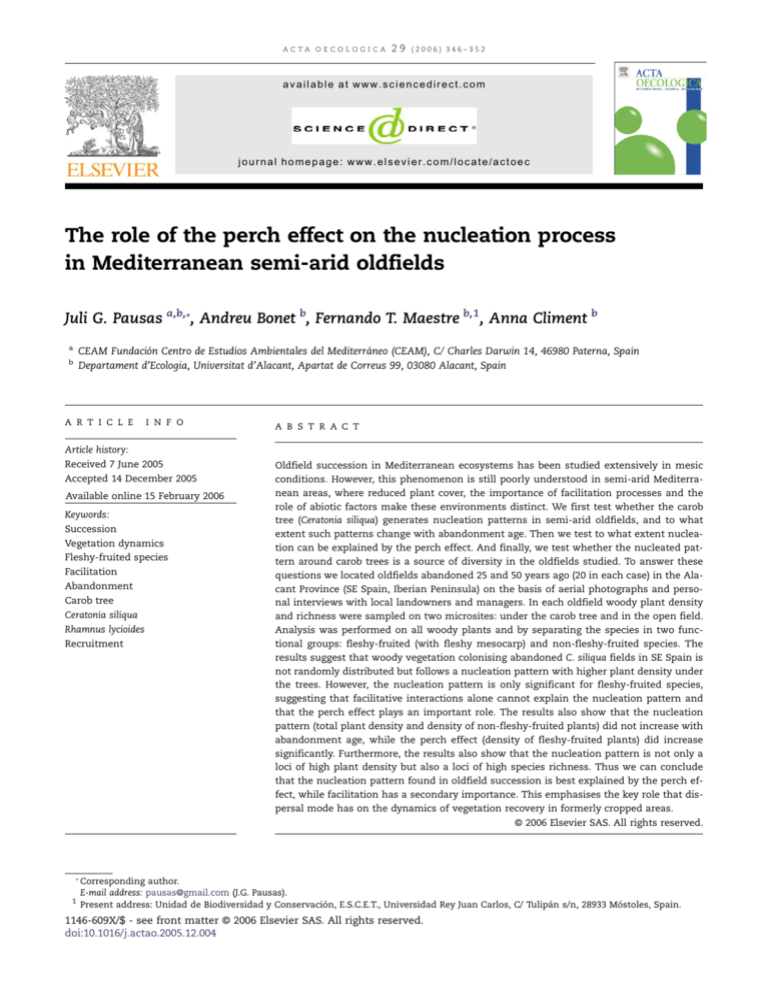
AC TA O E C O L O G I CA
29
(2006) 346–352
available at www.sciencedirect.com
journal homepage: www.elsevier.com/locate/actoec
The role of the perch effect on the nucleation process
in Mediterranean semi-arid oldfields
Juli G. Pausas a,b,*, Andreu Bonet b, Fernando T. Maestre b,1, Anna Climent b
a
CEAM Fundación Centro de Estudios Ambientales del Mediterráneo (CEAM), C/ Charles Darwin 14, 46980 Paterna, Spain
Departament d’Ecologia, Universitat d’Alacant, Apartat de Correus 99, 03080 Alacant, Spain
b
A R T I C L E
I N F O
A B S T R A C T
Article history:
Received 7 June 2005
Accepted 14 December 2005
Available online 15 February 2006
Keywords:
Succession
Vegetation dynamics
Fleshy-fruited species
Facilitation
Abandonment
Carob tree
Ceratonia siliqua
Rhamnus lycioides
Recruitment
Oldfield succession in Mediterranean ecosystems has been studied extensively in mesic
conditions. However, this phenomenon is still poorly understood in semi-arid Mediterranean areas, where reduced plant cover, the importance of facilitation processes and the
role of abiotic factors make these environments distinct. We first test whether the carob
tree (Ceratonia siliqua) generates nucleation patterns in semi-arid oldfields, and to what
extent such patterns change with abandonment age. Then we test to what extent nucleation can be explained by the perch effect. And finally, we test whether the nucleated pattern around carob trees is a source of diversity in the oldfields studied. To answer these
questions we located oldfields abandoned 25 and 50 years ago (20 in each case) in the Alacant Province (SE Spain, Iberian Peninsula) on the basis of aerial photographs and personal interviews with local landowners and managers. In each oldfield woody plant density
and richness were sampled on two microsites: under the carob tree and in the open field.
Analysis was performed on all woody plants and by separating the species in two functional groups: fleshy-fruited (with fleshy mesocarp) and non-fleshy-fruited species. The
results suggest that woody vegetation colonising abandoned C. siliqua fields in SE Spain is
not randomly distributed but follows a nucleation pattern with higher plant density under
the trees. However, the nucleation pattern is only significant for fleshy-fruited species,
suggesting that facilitative interactions alone cannot explain the nucleation pattern and
that the perch effect plays an important role. The results also show that the nucleation
pattern (total plant density and density of non-fleshy-fruited plants) did not increase with
abandonment age, while the perch effect (density of fleshy-fruited plants) did increase
significantly. Furthermore, the results also show that the nucleation pattern is not only a
loci of high plant density but also a loci of high species richness. Thus we can conclude
that the nucleation pattern found in oldfield succession is best explained by the perch effect, while facilitation has a secondary importance. This emphasises the key role that dispersal mode has on the dynamics of vegetation recovery in formerly cropped areas.
© 2006 Elsevier SAS. All rights reserved.
*
1
Corresponding author.
E-mail address: pausas@gmail.com (J.G. Pausas).
Present address: Unidad de Biodiversidad y Conservación, E.S.C.E.T., Universidad Rey Juan Carlos, C/ Tulipán s/n, 28933 Móstoles, Spain.
1146-609X/$ - see front matter © 2006 Elsevier SAS. All rights reserved.
doi:10.1016/j.actao.2005.12.004
ACTA OECOLOGICA
1.
Introduction
Given its importance as a global change driver (Houghton et
al., 2001), land use change and its ecological aspects are receiving increased interest. In the Mediterranean Basin, the socio-economic changes taking place during the last half of the
XX century promoted a dramatic rural exodus, with the consequent abandonment of large cultivated areas (Lepart and Debussche, 1992). As a result, these former cultivated areas are
now being colonised by early and late-successional vegetation,
a process that has important implications for processes such
as water balances (Bellot et al., 2001), wildfire regimes (Pausas,
2004) and carbon sequestration (DeGryze et al., 2004).
Oldfield succession in Mediterranean ecosystems has
been studied extensively in mesic conditions (Houssard et
al., 1980; Escarré et al., 1983; Peco et al., 1991; Lavorel et al.,
1994; Tatoni and Roche, 1994; Tatoni et al., 1994; Montalvo et
al., 1995; Debussche et al., 1996; Ne’eman and Izhaki, 1996).
However, this phenomenon is still poorly understood in
semi-arid Mediterranean areas (e.g. Noy-Meir, 1973; Martínez-Fernández et al., 1995; Margaris et al., 1996; Bonet, 2004;
Bonet and Pausas, 2004). Vegetation dynamics after land
abandonment under semi-arid conditions differ from that
observed in more mesic areas due to the reduced plant cover
that characterises the former (Whitford, 2002), the differences in the relative importance of interspecific interactions
such as facilitation and competition (Bertness and Callaway,
1994), and the overwhelming role that abiotic factors play on
the dynamics of plant populations (Escudero et al., 1999).
Successional processes in formerly cultivated areas are
strongly influenced by the nature of the crop that dominated
them. In areas formerly planted with tree crops (fruit orchards), it has been suggested that oldfield vegetation is spatially aggregated around the original crop tree (Debussche
and Isenmann, 1994). This process has been named ‘nucleation’ (Yarranton and Morrison, 1974) by analogy with other
physical processes, or ‘recruitment foci’ (McDonnell and
Stiles, 1983). This nucleation pattern can be generated by, at
least, two different ecological processes: the perch effect
and/or the facilitation effect through microenvironmental
and resource improvement (Gill and Marks, 1991; Verdú and
García-Fayos, 1996).
The perch effect refers to the process in which trees remaining from the orchards are used as perches by frugivorous
birds (Debussche et al., 1982). These birds swallow fruits from
the different shrubs and trees in remnant vegetation patches
around the oldfields and defecate and/or regurgitate the
seeds while perching in the old crop tree. Thus, seed rain
and the resulting seedling recruitment and sapling spatial
pattern should be highly patchy and largely restricted to microhabitats beneath trees (Izhaki et al., 1991; Debussche and
Lepart, 1992; Herrera et al., 1994; Debussche and Isenmann,
1994; Alcántara et al., 2000). However, high post-dispersal
seed predation beneath the woody vegetation (Kollmann,
1995; Hulme, 1998; Rey and Alcántara, 2000) could overwhelm
the increased seed rain from the perch effect and have no
consequences in the processes leading to final recruitment.
An alternative process for explaining the nucleation pattern is the facilitation effect (sensu Connell and Slatyer, 1977).
29
(2006) 346–352
347
Many studies have reported improvements in soil structure,
increases on soil nutrients and microbial activity, and amelioration of harsh microclimatic conditions under woody
plants in semi-arid environments, leading to the formation
of “resource islands” under the canopy of these plants (Jake
and Coughenour, 1990; Verdú and García-Fayos, 1996; Moro et
al., 1997; Reynolds et al., 1999). These resource islands are
points of high biological activity where facilitative interactions among plant species are dominant (Callaway, 1995;
Aguiar and Sala, 1999). Recent studies have emphasised the
importance of these interactions in driving plant community
structure and dynamics in semi-arid environments (Pugnaire
and Luque, 2001; Tewksbury and Lloyd, 2001; Maestre et al.,
2003a). In semi-arid oldfields changes in soil and microclimate as described above are also likely to occur around the
crop trees, and thus may be responsible for generating the
patchy pattern of nucleation.
To our knowledge, none of the studies conducted so far
has evaluated the relative importance of the perch and facilitation effects as drivers of vegetation dynamics in formerly
cultivated semi-arid areas. In the present paper we first test
whether carob trees (Ceratonia siliqua, Fabaceae subfamily
Caesalpinioideae) generate nucleation patterns in semi-arid
oldfields, and to what extent such patterns change with
abandonment age. Then we test to what extent nucleation
can be explained by the perch effect. If nucleation is observed in fleshy-fruited species only, then it should be
caused by the perch effect; otherwise (i.e. if nucleation is observed in both fleshy and non-fleshy-fruited), facilitation
(mediated by the improvement in soil conditions and the
amelioration of harsh climatic conditions) could be the main
driving force in the nucleation. Note that C. siliqua does not
produce fleshy-fruited bird-dispersed fruits and thus there is
no possible confounding between the pure perch effect and
the visit of birds attracted by fruits (reward). Furthermore,
we studied to what extent the nucleated pattern around
C. siliqua trees is not only a loci of high plant density but also
a source of diversity (diversity loci).
To answer these questions we sampled woody plant density (for both fleshy-fruited and non-fleshy-fruited species)
beneath and outside C. siliqua trees in semi-arid oldfields
abandoned 25 and 50 years ago in the south-eastern Iberian
Peninsula. Special emphasis was given to Rhamnus lycioides
(Rhamnaceae), the most abundant fleshy-fruited species in
the study area and common in other Mediterranean semiarid environments (Tutin et al., 1964–1980). This species is
also being increasingly used in the restoration of degraded
ecosystems in semi-arid Mediterranean areas (Bonet, 2004;
Cortina et al., 2004; Caravaca et al., 2003; Maestre et al.,
2003b).
2.
Methods
2.1.
Study area
The study was conducted at the Ventós-Agost Catchment Experimental Station (University of Alacant), in the Municipality of Agost, Alacant Province, SE Spain (38°28′N, 0°37′W, 10–
840 m a.s.l.). The catchment area (approx. 1537 ha) is charac-
348
ACTA OECOLOGICA
terised by a semi-arid Mediterranean climate, with a very
high interannual variability. Mean annual temperature is
18.2 °C and annual rainfall is 302 mm (Agost Meteorological
Station, 1961–1990 period). Soils have developed over marls
and calcareous bedrock, and slopes, which are mainly
south-facing, vary between 25% and 30%. Natural vegetation
is formed by a mosaic of Stipa tenacissima steppes, Brachypodium retusum grasslands with dwarf shrubs, and shrublands
dominated by Quercus coccifera and Erica multiflora (Bonet et
al., 2004). These formations are mixed with Pinus halepensis
plantations and dry woody crops like almond tree (Prunus
dulcis), olive tree (Olea europaea) and C. siliqua. Recently, setaside processes in the region have extended, and field abandonment ranges from 1 to 60 years following the last cultivation, with the main set-aside process taking place from 1946
to 1956 (Bonet et al., 2004).
2.2.
29
(2006) 346–352
tained plant density data by dividing the total number of individuals by the projected area of the C. siliqua tree (Tree microsite) and by the area of the oldfield (Field microsite).
Species richness and species density (number of species per
area) were also obtained for both microsites.
2.3.
Data analysis
The effect of microsite and abandonment age on plant density, species richness and species density were tested by twoway ANOVA. Prior to these analyses, the plant density data
were root-transformed, and the species density data were
log-transformed. For species richness, the Poisson error distribution was assumed in a GLM model (Margules et al., 1987;
Pausas, 1994; Pausas et al., 2003). Separate analyses were
conducted for all the species pooled, for fleshy-fruited species, for non-fleshy-fruited species and for R. lycioides.
Sampling
In 1999 we located all the oldfields containing a C. siliqua tree
in our study area using available digital cartography (Bonet et
al., 2004). Most fields in the area were relatively small and
had one or very few C. siliqua trees, sometimes in combination with cereal crops. We first preselected the fields that
had a single tree (Plate 1). From all these sites, we randomly
selected oldfields that had been abandoned 25 and 50 years
ago (20 oldfields in each case), on the basis of aerial photographs and personal interviews with local landowners and
managers (Bonet and Pausas, 2004). Abandonment is defined
here as the cessation of ploughing and sowing.
The selected oldfields were sampled during the springs of
1999 and 2000. The area of each oldfield and the projected
canopy area of each associated C. siliqua tree was measured.
All the woody species present underneath the canopy of the
C. siliqua trees (hereafter named Tree microsite) and outside
this canopy (hereafter named Field microsite) were counted.
Species were divided in two types: fleshy-fruited (with fleshy
mesocarp) and non-fleshy-fruited. From these data, we ob-
3.
A total of 31 woody species were found in the 40 oldfields
studied; nine of them were fleshy-fruited (Table 1). Woody
plant density (individuals·m–2) was significantly higher in
the Tree than in the Field microsite (3.26 ± 1.6 vs. 1.93 ± 1.3
individuals·m–2, respectively), but the effect of abandonment
age and the interaction were not significant (Table 2). However, if only the fleshy-fruited species are considered, the significance and the explained variance increased (Table 2). Fleshy-fruited species density was substantially higher (ca. 25
times) in the Tree than in the Field microsite (1.183 ± 0.89
vs. 0.046 ± 0.03), and these differences were especially pronounced in the 50-year oldfields (both the abandonment
age and the interaction were significant, Table 2 and Fig. 1).
The same pattern was observed for the density of R. lycioides
(Tables 1 and 2). The density of non-fleshy-fruited woody
species was similar in the two microsites (ca. 1.98 ± 1.4
individuals·m–2), but decreased with abandonment age
(P < 0.025, Table 2).
Total woody species richness was higher in the Field than
in the Tree microsite (Table 3), but this difference was likely
due to the fact that the field area (163 ± 197 m2) is much
higher (on average ca. seven times) than the area under the
tree (24.4 ± 11.8 m2). Despite these large differences in area
size between microsites, the number of fleshy-fruited species
was significantly higher in the Tree microsite compared to
the Field. For all species groups (total, fleshy and non-fleshy),
species density (number of species m–2) was significantly
higher in the Tree microsite (Table 3). Non-fleshy-fruited species richness tended to decrease with abandonment age,
while fleshy-fruited species increased or remained constant
with age (Table 3).
4.
Plate 1 – Oldfields with single carob trees (C. siliqua)
abandoned 25 years ago in the study area (Alacant, SE
Spain).
Results
Discussion
In the oldfields studied, woody species density was substantially higher beneath C. siliqua trees than in the open field;
that is, woody species colonisation of abandoned C. siliqua
ACTA OECOLOGICA
29
349
(2006) 346–352
Table 1 – List of woody species observed in the oldfields studied (fleshy-fruited and non-fleshy-fruited species) with their
abundance (mean number of individuals) in each microsite (N = 20): outside the canopy in the field terrace (Field) and
beneath the carob tree canopy (Tree), for both the 25 and 50 years old oldfields
Species name (Family)
25
Non-fleshy-fruited species
Fumana ericoides + F. thymifolia (Cistaceae)
Thymus vulgaris (Lamiaceae)
Anthyllis cytisoides + A. terniflora (Fabaceae)
Helianthemum violaceum (Cistaceae)
Teucrium homotrichum + T. murcicum (Lamiaceae)
Coronilla minima ssp. lotoides (Fabaceae)
Phagnalon saxatile + P. rupestre (Asteraceae)
Helianthemum syriacum (Cistaceae)
Sideritis leucantha (Lamiaceae)
Globularia alypum (Plantaginaceae)
Helichrysum stoechas (Asteraceae)
Dorycnium pentaphyllum (Fabaceae)
Haplophyllum linifolium ssp. rosmarinifolium (Rutaceae)
Bupleurum fruticescens (Apiaceae)
Cheirolophus intybaceus (Asteraceae)
Thymelaea hirsuta (Thymelaeaceae)
Ruta angustifolia (Rutaceae)
E. multiflora (Ericaceae)
Fleshy-fruited species
R. lycioides (Rhamnaceae)
Asparagus horridus (Liliaceae)
Juniperus oxycedrus (Cupressaceae)
Ephedra fragilis (Ephedraceae)
Osyris lanceolata (Santalaceae)
P. lentiscus (Anacardiaceae)
O. europaea var. sylvestris (Oleaceae)
Arbutus unedo (Ericaceae)
Rhamnus alaternus (Rhamnaceae)
Field
50
Tree
50
25
40.2
22.4
21.4
18.5
4.8
3.6
15.4
10.9
8.3
0.35
5.2
3.8
0
0.6
0
2.8
0
0.1
55.1
36.1
23.5
21.0
23.5
29.0
9.4
13.3
8.3
16.8
9.7
2.3
5.4
3.5
3.8
0.35
1.2
0.65
2.7
3.2
7.9
8.1
2.2
0.85
5.7
1.5
3.0
0.05
0.6
0.85
0.05
0.25
0
0.8
0
0.3
2.3
5.2
3.9
3.5
8.7
3.5
1.1
1.3
1.2
2.5
0.6
0.5
1.1
1.1
0.75
0
1.4
0
0.9
2.7
0.1
0
0.1
0
0
0
0
2.1
4.5
0.7
0.2
0.1
0
0
0
0
8.9
1.6
0.2
0.15
0.15
0
0.1
0
0
44.15
5.7
0.4
1
0.65
0.35
0.25
0.1
0.05
Species are sorted by their mean abundance. Nomenclature following Mateo and Crespo (2001) for species, and The Angiosperm Phylogeny
Group (Bremer et al., 1998) for family names. Some closely related species were aggregated to avoid some uncertainties in the plots that the
individuals were poorly developed.
Table 2 – Mean density of woody plants (individuals·m–2) and two-way ANOVA for total, fleshy-fruited and non-fleshyfruited species and for R. lycioides in relation with the different microsite (Tree vs. Field, M) and abandonment age (25 vs. 50
years, A)
Plant density (individuals m–2)
Field
Tree
Total species
Fleshy-fruited species
Non-fleshy-fruited species
R. lycioides
25
2.10
0.045
2.06
0.010
50
1.75
0.048
1.71
0.012
25
3.12
0.56
2.56
0.456
50
3.40
1.80
1.60
1.485
fields in semi-arid conditions was not randomly distributed
but instead followed a nucleation pattern. The fact that this
pattern was highly significant for fleshy-fruited species
alone, and not for the remaining species (Table 2), suggests
that facilitative interactions only cannot explain it, and that
increased seed rain due to the perch effect should be invoked. For instance, the density of R. lycioides, a bird-dispersed species (Jordano and Herrera, 1981; Jordano, 1987),
showed a clear nucleation pattern (Table 3). Similar patterns
have found for other species of the same genus, such as
R. alaternus (Gulias et al., 2004) and R. ludovici-salvatoris
(Traveset et al., 2003), in Mediterranean shrublands. Likewise,
nucleation patterns around orchard trees have been observed for other fleshy-fruited bird-dispersed Mediterranean
species such as Pistacia lentiscus and Daphne gnidium in areas
formerly cropped with C. siliqua and O. europaea, respectively
(Verdú and García-Fayos, 1996, 1998). To what extent, the nu-
Microsite (M)
F1,76
19.4
200.4
0.01
217.6
P
< 0.0001
< 0.0001
0.815
< 0.0001
ANOVA
Abandonment
age (A)
F1,76
0.02
37.9
5.2
35.0
P
0.87
< 0.0001
< 0.025
< 0.0001
M×A
F1,76
1.38
35.9
1.18
30.5
P
0.24
< 0.0001
0.28
< 0.0001
R2
0.215
0.783
0.078
0.788
cleation pattern in each of the above cases is due to the
perch effect or to facilitation mediated by improved environmental conditions under the canopy of shrubs and/or trees is
difficult to know, and perhaps both processes may be relevant in the recruitment of Mediterranean fleshy-fruited species (Gulias et al., 2004). Furthermore, in the case of
O. europaea, bird perching may be due to the vertical structure
but also to the attraction by the fleshy fruits of this species.
Our results suggest that the perch effect may be more relevant than the facilitation effect in driving the dynamics of
oldfield vegetation in semi-arid environments, at least during the time frame evaluated here. This does not minimise
the importance of facilitation as a driver of vegetation dynamics in these and other environments, but rather emphasises the overwhelming role that dispersal mode has on the
dynamics of vegetation recovery in formerly cropped areas
(Bonet and Pausas, 2004). Future experiments on seed rain
350
ACTA OECOLOGICA
29
(2006) 346–352
Fig. 1 – Median (horizontal line), first and third quantiles (box) and extreme values on woody plant density (expressed as
the square root of the number of individuals m–2) of fleshy-fruited species (left) and non-fleshy-fruited species (right)
observed on the two microsites (Tree, beneath C. siliqua trees, and Field, outside the tree) for 25 and 50 years old oldfields.
See Table 3 for the statistical analyses of these data.
Table 3 – Mean species richness and density (number of species·m–2) and two-way ANOVA for total, fleshy-fruited and nonfleshy-fruited species (N = 20) in relation with the different microsite (Tree vs. Field, M) and abandonment age (25 vs. 50
years, A)
25
Field
50
25
Tree
50
Number of species
Total species
12.15
14.65
9.05
9.90
Fleshy-fruited species
1.45
2.00
1.85
3.30
Non-fleshy-fruited species
10.70
12.65
7.20
6.60
Species density (# m–2)
Total species
0.16
0.10
0.65
0.40
Fleshy-fruited species
0.02
0.014
0.11
0.12
Non-fleshy-fruited species
0.15
0.08
0.53
0.28
For species richness data, a Poisson analysis is used; species density data were log-transformed.
would be needed for a better quantification of the role of
seed dispersal.
It is interesting to mention that the nucleation pattern
(total plant density and non-fleshy-fruited plant density)
did not increase with abandonment age, while the perch effect (fleshy-fruited plant density) did (Table 2). Both fleshyfruited plant density and R. lycioides density were higher beneath C. siliqua trees than in the field, and the magnitude of
these differences were larger in 50-year-old fields than in 25year-old fields (significant interactions in Table 2). This result
suggests that the perch effect increases in importance along
succession. This trend can be explained by the higher seed
rain due to the longer time since abandonment (Debussche
and Isenmann, 1994). Furthermore, there may also be a positive feedback in which fleshy-fruited species establish and
produce fruits below the perch tree, and these additional
fruits attract more birds (Sargent, 1990), further increasing
the seed rain under the C. siliqua tree canopy.
The microsite beneath the C. siliqua tree represents a “diversity loci” in semi-arid oldfields, as described for other
woody species in desert shrublands (Tewksbury and Lloyd,
Microsite
ANOVA P-values
Age
M×A
< 0.0001
0.009
< 0.0001
0.027
0.002
0.32
0.469
0.42
0.09
< 0.0001
< 0.0001
< 0.0001
0.0005
0.453
0.00017
0.339
0.137
0.80
2001) and semi-arid steppes (Maestre and Cortina, 2005).
That is, in our conditions, bird-mediated seed rain of fleshyfruited species generates a high spatial variability in both
plant density and diversity, and this variability is dependent
on the vertical vegetation structures remaining from the
abandoned orchard. In fact, it has been recognised that after
tree crop abandonment in Mediterranean landscapes, vegetation does not follow the traditional path from “early-successional” species to “late-successional” species; rather, the
so-called “late-successional” species may appear early after
abandonment (Ne’eman and Izhaki, 1996; Bonet, 2004; Bonet
and Pausas, 2004). This early appearance of “late-successional” species is due to the perch effect.
These results may have important implications in the
management of semi-arid Mediterranean ecosystems. The
long-time human pressure (e.g. grazing, wood harvesting,
massive cultivation and terracing and then massive abandonment) in these systems has degraded many of the semiarid landscapes of the Mediterranean Basin (Jauffret and Lavorel, 2003; Maestre and Cortina, 2004a; Bonet et al., in press).
Currently, there is strong social pressure to restore or accel-
ACTA OECOLOGICA
erating natural processes of regeneration in these landscapes
(Pausas et al., 2004; Vallejo et al., 2006). The limited success
of conventional restoration activities in semi-arid Mediterranean areas (see Maestre and Cortina, 2004b for a discussion),
emphasises the need of incorporating ecosystems-specific
structural and functional processes into their active management. The fact that the perch effect provides important seed
rain for regeneration and for increasing diversity in a variety
of environments opens up the possibility of using artificial
perching sites for accelerating landscape regeneration. This
technique has been applied mainly under tropical conditions
(McDonnell, 1986; Holl, 1998) and, to our knowledge, has not
been experimentally tested under semi-arid conditions.
Further experimental studies are thus needed to evaluate
the suitability of this technique for Mediterranean semi-arid
landscapes.
Acknowledgements
This research was funded by Ministerio de Educación y Ciencia (CICYT project CGL2004-03627). F.T.M. was supported by a
Spanish Ministry of Education and Science Fulbright fellowship (FU2003-0398). CEAM is funded by the “Generalitat Valenciana” and “Bancaixa”.
R E F E R E N C E S
Aguiar, M.R., Sala, O.E., 1999. Patch structure, dynamics and
implications for the functioning of arid ecosystems.
Trends Ecol. Evol. 14, 273–277.
Alcántara, J.M., Rey, P.J., Valera, F., Sánchez-Lafuente, A.M.,
2000. Factors shaping the seedfall pattern of a bird-dispersed plant. Ecology 81, 1937–1950.
Bremer, K., Chase, M.W., Stevens, P.F., 1998. An ordinal classification for the families of flowering plants. Ann. Miss.
Bot. Gard. 85, 531–553 (coordinators).
Bertness, M., Callaway, R.M., 1994. Positive interactions in
communities. Trends Ecol. Evol. 9, 191–193.
Bonet, A., 2004. Secondary succession on semi-arid Mediterranean old-fields in South-eastern Spain: insights for conservation and restoration of degraded lands. J. Arid Environ. 56, 213–233.
Bonet, A., Bellot, J., Peña, J., 2004. Landscape dynamics in a
semiarid Mediterranean catchment (SE Spain). In: Mazzoleni, S., Di Pasquale, G., de Martino, P., Rego, F. (Eds.), Recent Dynamics of Mediterranean Vegetation and Landscape. Wiley, Chichester, pp. 47–56.
Bonet A, Bellot J, Eisenhuth D, Peña J, Sánchez JR, Tejada CJ.
in press. Some evidence of landscape change, water usage
and management system co-dynamics in south-eastern
Spain. In: Koundouri, P., Karousakis, K., Assimacopoulos,
D., Jeffrey, P., Lange, M. (Eds.), Water Management in Arid
and Semi-Arid Regions: Interdisciplinary Perspectives. Edward Elgar, Aldershot.
Bonet, A., Pausas, J.G., 2004. Species richness and cover along
a 60-year chronosequence in old-fields of southeastern
Spain. Plant. Ecol. 174, 257–270.
Bellot, J., Bonet, A., Sánchez, J.R., Chirino, E., 2001. Likely effects of land use changes on the runoff and aquifer recharge in a semiarid landscape using a hydrological model. Lands. Urban Plann. 55, 41–53.
29
(2006) 346–352
351
Callaway, R.M., 1995. Positive interactions among plants. Bot.
Rev. 61, 306–349.
Caravaca, F., Figueroa, D., Roldán, A., Azcón-Aguilar, C., 2003.
Alteration in rhizosphere soil properties of afforested
Rhamnus lycioides seedlings in short-term response to mycorrhizal inoculation with Glomus intraradices and organic
amendment. Environ. Manage. 31, 412–420.
Connell, J.H., Slatyer, R.O., 1977. Mechanisms of succession in
natural communities and their role in community stability and organization. Am. Nat. 111, 1119–1144.
Cortina, J., Bellot, J., Vilagrosa, A., Caturla, R., Maestre, F.T.,
Rubio, E., et al., 2004. Restauración en semiárido. In: Vallejo, R., Alloza, J.A. (Eds.), Avances en el Estudio de la Gestión del Monte Mediterráneo, Fundación CEAM. Valencia,
pp. 345–406.
Debussche, M., Lepart, J., 1992. Establishment of woody
plants in Mediterranean succession old fields: opportunity
in space and time. Lands. Ecol. 6, 133–145.
Debussche, M., Isenmann, P., 1994. Bird-dispersed seed rain
and seedling establishment in a patchy Mediterranean region. Oikos 69, 414–426.
Debussche, M., Escarré, J., Lepart, J., 1982. Ornithochory and
plant succession in Mediterranean abandoned orchards.
Vegetatio 48, 255–266.
Debussche, M., Escarré, J., Lepart, J., Houssard, C., Lavorel, S.,
1996. Changes in Mediterranean plant succession: oldfields revisited. J. Veg. Sci. 7, 519–526.
DeGryze, S., Six, J., Paustian, K., Morris, S.J., Paul, E.A., Merckx,
R., 2004. Soil organic carbon pool changes following landuse conversions. Glob. Change Biol. 10, 1120–1132.
Escarré, J., Houssard, C., Debussche, M., 1983. Évolution de la
végétation et du sol après abandon cultural en région
méditerranéenne: étude de succession dans le Garrigues
du Montpelliérais (France). Acta Oecol. 4, 221–239.
Escudero, A., Somolinos, R.C., Olano, J.M., Rubio, A., 1999. Factors controlling the establishment of Helianthemum squamatum, an endemic gypsophile of semi-arid Spain. J. Ecol.
87, 290–302.
Gill, D.S., Marks, P.L., 1991. Tree and shrub seedling colonization of old fields in central New York. Ecol. Monogr. 61,
183–205.
Gulias, J., Traveset, A., Riera, N., Mus, M., 2004. Critical stages
in the recruitment process of Rhamnus alaternus L. Ann.
Bot. (Lond.) 93, 723–731.
Herrera, C.M., Jordano, P., López-Soria, L., Amat, J.A., 1994. Recruitment of a mast-fruiting, bird-dispersed tree: bridging
frugivore activity and seedling establishment. Ecol.
Monogr. 64, 315–344.
Houghton, J.T., Ding, Y., Griggs, D.J., Noguer, M., van der Linden, P.J., Dai, X., et al., 2001. In: Climate Change 2001: The
Scientific Basis. Contribution of Working Group I to the
Third Assessment Report of the Intergovernmental Panel
on Climate Change. Cambridge University Press, Cambridge and New York.
Houssard, C., Escarré, J., Romane, F., 1980. Development of
species diversity in some Mediterranean plant communities. Vegetatio 43, 59–72.
Holl, K.D., 1998. Do bird perching structures elevate seed rain
and seedling establishment in abandoned tropical pastures? Restor. Ecol. 6, 253–261.
Hulme, P.E., 1998. Post-dispersal seed predation: consequences for plant demography and evolution. Persp. Plant
Ecol. Syst. 1, 32–46.
Izhaki, I., Walton, P.B., Safriel, U.N., 1991. Seed shadows generated by frugivorous birds in an eastern Mediterranean
scrub. J. Ecol. 79, 575–590.
Jake, W.F., Coughenour, M.B., 1990. Savanna tree influence on
understorey vegetation and soil nutrients in north-western Kenya. J. Veg. Sci. 1, 325–334.
352
ACTA OECOLOGICA
Jauffret, S., Lavorel, S., 2003. Are plant functional types relevant to describe degradation in arid, southern Tunisian
steppes? J. Veg. Sci. 14, 399–408.
Jordano, P., 1987. Frugivory, external morphology and digestive system in Mediterranean sylviid warblers Sylvia spp.
Ibis 129, 175–189.
Jordano, P., Herrera, C.M., 1981. The frugivorous diet of blackcap populations of Sylvia atricapilla wintering in southern
Spain. Ibis 123, 502–507.
Kollmann, J., 1995. Regeneration window for fleshy-fruited
plants during scrub development on abandoned grasslands. Écoscience 2, 213–222.
Lavorel, S., Lepart, J., Debussche, M., Lebreton, J.D., Beffy, J.L.,
1994. Small scale disturbances and the maintenance of
species diversity in Mediterranean old fields. Oikos 70,
455–473.
Lepart, J., Debussche, M., 1992. Human impact on landscape
patterning: Mediterranean examples. In: Handsen, A.J., Di
Castri, F. (Eds.), Landscape Boundaries, Consequences for
Biotic Diversity and Ecological Flows. Springer, New York,
pp. 76–106.
Maestre, F.T., Bautista, S., Cortina, J., 2003. Positive, negative,
and net effects in grass–shrub interactions in Mediterranean semiarid grasslands. Ecology 84, 3186–3197.
Maestre, F.T., Cortina, J., Bautista, S., Bellot, J., 2003. Does Pinus halepensis facilitate the establishment of shrubs under
semi-arid climate? For. Ecol. Manage. 176, 147–160.
Maestre, F.T., Cortina, J., 2004. Insights into ecosystem composition and function in a sequence of degraded semiarid
steppes. Restor. Ecol. 12, 494–502.
Maestre, F.T., Cortina, J., 2004. Are Pinus halepensis plantations
useful as a restoration tool in semiarid Mediterranean
areas? For. Ecol. Manage. 198, 303–317.
Maestre, F.T., Cortina, J., 2005. Remnant shrubs in Mediterranean semi-arid steppes: effects of shrub size, abiotic factors and species identity on understorey richness and occurrence. Acta Oecol. 27, 161–169.
Margaris, N.S., Koutsidou, E., Gioura, C., 1996. Changes in traditional Mediterranean land-use systems. In: Brandt, J.,
Thornes, J.B. (Eds.), Mediterranean Desertification and
Land Use. Wiley, Chischester, pp. 29–42.
Margules, C.R., Nicholls, A.O., Austin, M.P., 1987. Diversity of
Eucalyptus species predicted by a multi-variable environmental gradient. Oecologia 71, 229–232.
Martínez-Fernández, J., López-Bermúdez, F., Martínez-Fernández, J., Romero-Díaz, A., 1995. Land use and soil–vegetation relationships in a Mediterranean ecosystem: El Ardal, Murcia, Spain. CATENA 25, 153–167.
Mateo, G., Crespo, M.B., 2001. Manual para la determinación
de la flora valenciana (2º Edición). Ed. Moliner-40. Monografías Flora Montiberica, Valencia.
McDonnell, M.J., 1986. Old field vegetation height and the dispersal pattern of bird disseminated woody plants. Bull.
Torrey Bot. Club. 113, 6–11.
McDonnell, M.J., Stiles, E.W., 1983. The structural complexity
of old field vegetation and the recruitment of bird-dispersed plant species. Oecologia 56, 109–116.
Montalvo, J., Casado, M.A., Levassor, C., Pineda, F.D., 1995. The
strategies of ecological succession: theoretical insights
from experimentally disturbed ecosystems. In: Bellan, D.,
Bonin, G., Emig, C. (Eds.), Functioning and Dynamics of
Natural and Perturbed Ecosystems. Lavoisier Publs., Intercept Ltd., Paris, pp. 231–261.
Moro, M.J., Pugnaire, F.I., Haase, P., Puigdefábregas, J., 1997. Effect of the canopy of Retama sphaerocarpa on its understorey in a semiarid environment. Funct. Ecol. 11, 425–431.
29
(2006) 346–352
Ne’eman, G., Izhaki, I., 1996. Colonization in an abandoned
East Mediterranean vineyard. J. Veg. Sci. 7, 465–472.
Noy-Meir, I., 1973. Desert ecosystems: environment and producers. Ann. Rev. Ecol. Syst. 4, 25–51.
Pausas, J.G., 1994. Species richness patterns in the understorey of Pyrenean Pinus sylvestris forest. J. Veg. Sci. 5, 517–524.
Pausas, J.G., 2004. Changes in fire and climate in the eastern
Iberian Peninsula (Mediterranean Basin). Clim. Change 63,
337–350.
Pausas, J.G., Carreras, J., Ferré, A., Font, X., 2003. Coarse-scale
plant species richness in relation to environmental heterogeneity. J. Veg. Sci. 14, 661–668.
Pausas, J.G., Bladé, C., Valdecantos, A., Seva, J.P., Fuentes, D.,
Alloza, J.A., et al., 2004. Pines and oaks in the restoration
of Mediterranean landscapes of Spain: new perspectives
for an old practice—a review. Plant Ecol. 171, 209–220.
Peco, B., Sánchez, G., Casado, M.A., Pineda, F.D., 1991. Dinamismo de la diversidad y estructura espacial de pastizales
mediterráneos periódicamente perturbados. In: Pineda, F.
D., Casado, M.A., De Miguel, J.M., Montalvo, J. (Eds.), Diversidad biológica/Biological Diversity. F. Areces-ADENASCOPE, Madrid, pp. 215–218.
Pugnaire, F.I., Luque, M.T., 2001. Changes in plant interactions along a gradient of environmental stress. Oikos 93,
42–49.
Rey, P.J., Alcántara, J.M., 2000. Recruitment dynamics of a fleshy-fruited plant (Olea europaea): connecting patterns of
seed dispersal to seedling establishment. J. Ecol. 88, 622–
633.
Reynolds, J.F., Virginia, R.A., Kemp, P.R., De Soyza, A.G., Tremmel, D.C., 1999. Impact of drought on desert shrubs: effects of seasonality and degree of resource island development. Ecol. Monogr. 69, 69–106.
Sargent, S., 1990. Neighborhood effects on fruit removal by
birds: a field experiment with Viburnum dentatum Caprifoliaceae. Ecology 71, 1289–1298.
Tatoni, T., Roche, P., 1994. Comparison of old-field and forest
revegetation dynamics in Province. J. Veg. Sci. 5, 295–302.
Tatoni, T., Magnin, F., Bonin, G., Vaudour, J., 1994. Secondary
succession on abandoned cultivation terraces in calcareous Province. I- Vegetation and soil. Acta Oecol. 15, 431–
447.
Tewksbury, J.J., Lloyd, J.D., 2001. Positive interactions under
nurse plants: spatial scale, stress gradients and benefactor
size. Oecologia 127, 425–434.
Traveset, A., Gulías, J., Riera, N., Mus, M., 2003. Transition
probabilities from pollination to establishment in a rare
shrub species (Rhamnus ludovici-salvatoris) in two habitats.
J. Ecol. 91, 427–437.
Tutin, T.G., et al., 1964–1980. Flora Europaea. Cambridge University Press, Cambridge.
Vallejo, R., Aronson, J., Pausas, J.G., Cortina, J., 2006. Restoration of Mediterranean Woodlands. In: van Andel, J., Aronson, J. (Eds.), Restoration Ecology: The New Frontier. Blackwell Science, Malden, pp. 193–207.
Verdú, M., García-Fayos, P., 1996. Nucleation processes in a
Mediterranean bird-dispersed plant. Funct. Ecol. 10, 275–
280.
Verdú, M., García-Fayos, P., 1998. Old-field colonization by
Daphne gnidium: seedling distribution and spatial dependence at different scales. J. Veg. Sci. 9, 713–718.
Whitford, W.G., 2002. Ecology of Desert Systems. Academic
Press, London.
Yarranton, G.A., Morrison, R.G., 1974. Spatial dynamics of a
primary succession: nucleation. J. Ecol. 62, 417–428.

